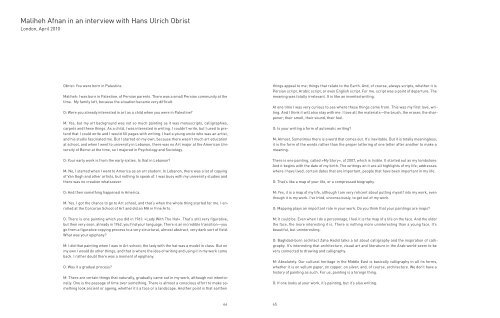Maliheh-Afnan-Tonight…-Galerie-Kornfeld-Berlin-2014
Maliheh-Afnan-Tonight…-Galerie-Kornfeld-Berlin-2014
Maliheh-Afnan-Tonight…-Galerie-Kornfeld-Berlin-2014
Create successful ePaper yourself
Turn your PDF publications into a flip-book with our unique Google optimized e-Paper software.
<strong>Maliheh</strong> <strong>Afnan</strong> in an interview with Hans Ulrich Obrist<br />
London, April 2010<br />
Obrist: You were born in Palestine.<br />
<strong>Maliheh</strong>: I was born in Palestine, of Persian parents. There was a small Persian community at the<br />
time. My family left, because the situation became very difficult.<br />
O: Were you already interested in art as a child when you were in Palestine<br />
M: Yes, but my art background was not so much painting as it was manuscripts, calligraphies,<br />
carpets and these things. As a child, I was interested in writing. I couldn’t write, but I used to pretend<br />
that I could write and I would fill pages with writing. I had a young uncle who was an artist,<br />
and his studio fascinated me. But I started on my own, because there wasn’t much art education<br />
at school, and when I went to university in Lebanon, there was no Art major at the American University<br />
of Beirut at the time, so I majored in Psychology and Sociology.<br />
O: Your early work is from the early sixties. Is that in Lebanon<br />
M: No, I started when I went to America as an art student. In Lebanon, there was a lot of copying<br />
of Van Gogh and other artists, but nothing to speak of. I was busy with my university studies and<br />
there was no creation whatsoever.<br />
O: And then something happened in America.<br />
M: Yes. I got the chance to go to Art school, and that’s when the whole thing started for me. I enrolled<br />
at the Corcoran School of Art and did an MA in Fine Arts.<br />
O: There is one painting which you did in 1961: »Lady With The Hat«. That’s still very figurative,<br />
but then very soon, already in 1962, you find your language. There is an incredible transition—you<br />
go from a figurative copying process to a very structural, almost abstract, very dark sort of field.<br />
What was your epiphany<br />
M: I did that painting when I was in Art school; the lady with the hat was a model in class. But on<br />
my own I would do other things, and that is where the idea of writing and using it in my work came<br />
back. I rather doubt there was a moment of epiphany.<br />
O: Was it a gradual process<br />
M: There are certain things that naturally, gradually came out in my work, although not intentionally.<br />
One is the passage of time over something. There is almost a conscious effort to make something<br />
look ancient or ageing, whether it’s a face or a landscape. Another point is that earthen<br />
things appeal to me; things that relate to the Earth. And, of course, always scripts, whether it is<br />
Persian script, Arabic script, or even English script. For me, script was a point of departure. The<br />
meaning was totally irrelevant. It is like an invented writing.<br />
At one time I was very curious to see where these things came from. This was my first love, writing.<br />
And I think it will also stay with me. I love all the materials—the brush, the eraser, the sharpener;<br />
their smell, their sound, their feel.<br />
O: Is your writing a form of automatic writing<br />
M: Almost. Sometimes there is a word that comes out. It’s inevitable. But it is totally meaningless;<br />
it is the form of the words rather than the proper lettering of one letter after another to make a<br />
meaning.<br />
There is one painting, called »My Story«, of 2007, which is lisible. It started out as my tombstone.<br />
And it begins with the date of my birth. The writings on it are all highlights of my life; addresses<br />
where I have lived, certain dates that are important, people that have been important in my life.<br />
O: That’s like a map of your life, or a compressed biography.<br />
M: Yes, it is a map of my life, although I am very reticent about putting myself into my work, even<br />
though it is my work. I’ve tried, unconsciously, to get out of my work.<br />
O: Mapping plays an important role in your work. Do you think that your paintings are maps<br />
M: It could be. Even when I do a personnage, I feel it is the map of a life on the face. And the older<br />
the face, the more interesting it is. There is nothing more uninteresting than a young face. It’s<br />
beautiful, but uninteresting.<br />
O: Baghdad-born architect Zaha Hadid talks a lot about calligraphy and the inspiration of calligraphy.<br />
It’s interesting that architecture, visual art and literature in the Arab world seem to be<br />
very connected to drawing and calligraphy.<br />
M: Absolutely. Our cultural heritage in the Middle East is basically calligraphy in all its forms,<br />
whether it is on vellum paper, on copper, on silver; and, of course, architecture. We don’t have a<br />
history of painting as such. For us, painting is a foreign thing.<br />
O: If one looks at your work, it’s painting, but it’s also writing.<br />
44 45


